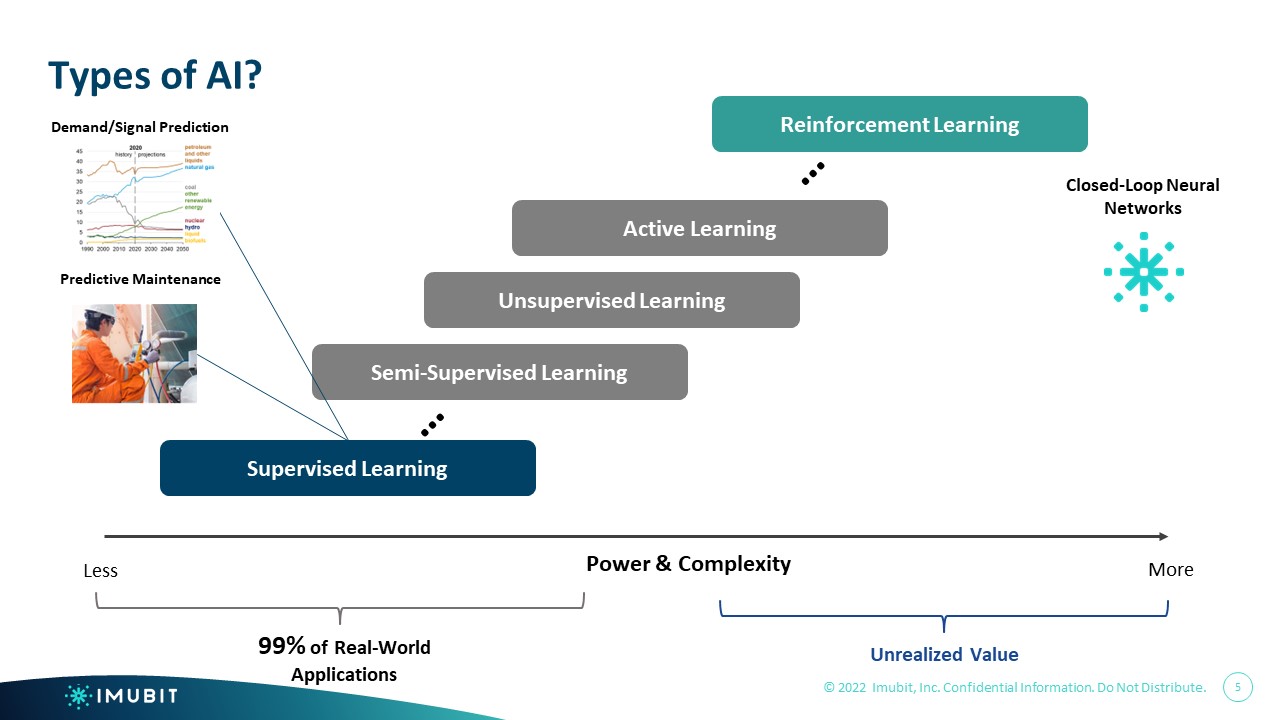
Discover
Leverage data from a variety
of plant data sources

Capture
Visualize real-time value generation, change
constraints and targets all on-premises

Sustain
Rationalize model decisions by running
through “what-if” simulations
EXPLAINER VIDEO
Model Plant Reality
As a process engineer, you understand the dynamic, complex, and non-linear nature of refining processes. To effectively model process relationships, often key variables or measurements are not available. Creating a simulation of the plant that matches reality is a challenge.
With Imubit’s Closed Loop Neural Network solution, process engineers can build Deep Learning dynamic simulators on years of historical plant data to discover the true process relationships at the plant. Learn more about Imubit’s approach and use of Deep Reinforcement Learning.
CASE STUDY
Hydrocracker Yield Improvement
Evaluate the benefits associated with plant improvements with precision and confidence. Imubit’s advanced analytics provide you with deep insights, enabling you to make data-driven decisions that drive superior ROI. Discover how this client used Imubit to help them understand the bigger picture.
Read the story >

Ready to discover your plant’s process relationships?
Optimizing FCCUs
Watch this Case Study presentation as we walk through a customer’s journey of identifying the high-value optimization opportunity around their FCCU and their results after applying Imubit’s Closed Loop Neural Network. In addition, we will dive into the process relationships learned by Imubit’s model and show how Closed Loop Neural Networks can understand the impact of changing catalyst activity on product yields for real-time control and optimization.
BUYER’S GUIDE
What is AI?
AI is as commonplace as using technology in the world today. It’s hard to understand what is AI and when to use it. Learn about AI as we define it back to it’s scientific definition and then turn our focus to the most-advanced form of AI used in Imubit’s solution, Deep Reinforcement Learning.
Watch now >

Your Team
Work with your Account Executive and Economic Engineer to build the business case for Closed Loop Neural Networks at your plant. Contact your team to learn about our no-cost process to accurately define the baseline and calculate potential value generation, working with your guidance the entire time.
FAQs
How does the DLPC model account for process dynamics?
DLPC uses historical data to learn the dynamic relationships between model variables in order to predict and control constraints effectively when running in a closed loop. During model training, DLPC learns a multitude of gains (process relationships) and understands time dynamics for each independent-dependent relationship through the process of predicting dependent variables dynamically. Through this process, DLPC now has a process model that reflects the reality of the plant. Because DLPC is learning relationships based on actual process historical data, the process dynamics and nonlinearity is captured during training.
How does the DLPC model account for process upsets or shutdowns?
During model development, time periods that include process upsets or unit shutdowns/startups are removed from the training data. Minimum and maximum threshold values that are outside of normal operating range for different process variables (e.g. flow, temperature, pressure) are also excluded from the training data if deemed unrepresentative of the process system.
How does the DLPC model account for major operational changes?
For major operational changes or shifts, the DLPC model will likely need to be retrained with data that includes the new regime. On average, 2-3 months of high-quality data is required, but the actual amount of data depends on the change. If the operational shift has occurred in history, and the model was trained with the relevant historical data, it is likely that the model performance will not degrade. If the operational change or strategy is new, the Imubit team will evaluate the scope of the change and align with the client to determine the path forward.
How much data is required to train a DLPC model?
The data required to train a DLPC model needs to adequately represent the process, which can be highly dependent on data compression rates or recent operational changes. Imubit recommends using at least 3-4 months of high quality (ideally, uncompressed) data to train and develop a robust model. While there is no limit on the maximum amount of data, models are typically trained with 2-5 years of historical data. If there is a significant process shift in the unit (i.e. turnaround, modifications to equipment), an average of 2-3 months of high-quality data with the new operating regime is recommended for a retrain. For inferentials, Imubit recommends a minimum of 200 lab sample data points, but this also depends on data quality.
How does DLPC respect constraints?
DLPC is trained to not violate Manipulated Variable (MV) operating limits and to avoid Control Variable (CV) operating limit violation. The on-site DLPC Application provides a second layer of protection that will prevent the DLPC from violating MV bounds during closed loop. DLPC will only write out a setpoint within the specified upper and lower bounds. CV bounds are respected and will take precedence over optimization objectives.
How does DLPC respect mass balances?
Data is validated before training with the customer to ensure mass balances are closing within reason. Additionally, during model training, the model learns based on changes in values rather than absolute values which makes it less prone to issues where signals are off by a fixed amount. Imubit also uses flow correction techniques and other approaches to ensure models respect mass balances and other critical first principle relationships.
What is provided to educate on how DLPC works and why it makes its moves?
Imubit’s Closed Loop Neural NetworkTM solution offers various applications and visuals for plant experts to build confidence with their models. Every DLPC model will have a variable relationship matrix, or gains matrix, a visual representation of the nonlinear relationships that the model has learned. Imubit engineers will work closely with the site engineers throughout model development and commissioning to ensure that they learn how to interpret the nonlinear gains and develop a fundamental understanding of the model. Imubit will also provide access to Model Evaluation Applications to simulate the on-site model under different constraints or optimization strategies to gain a better understanding of the model performance.
How easy is it to add/remove variables from the DLPC model?
Adding and/or removing variables in the DLPC model will require a retrain of the model. If the model is trained with flexible constraints, a retrain is not required to flex the constraint on/off.
How often does the DLPC model need to be retrained once it is running online?
Retrains for stable, 24/7 models will be evaluated at least once a quarter to ensure model performance is as expected. Based on services rendered, Imubit can also monitor and meet regularly to discuss current model performance. Additional model retrains may also be required based on discussions on model performance, changes in operational constraints or operating strategy, or if model variables need to be changed.
How long does it take to retrain a DLPC model?
DLPC model retrains can take from several days to four weeks depending on the complexity of the retrain. Simple retrains (e.g. updating bounds, adding new data) can usually be turned around quickly. Complex retrains (e.g. adding/removing variables, updating the objective function) will require more time for data analysis and model evaluation.

